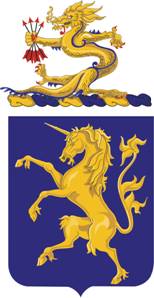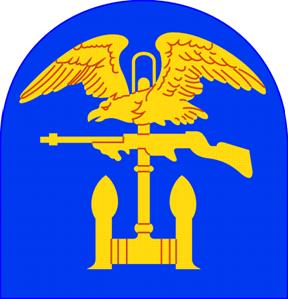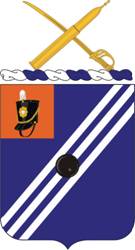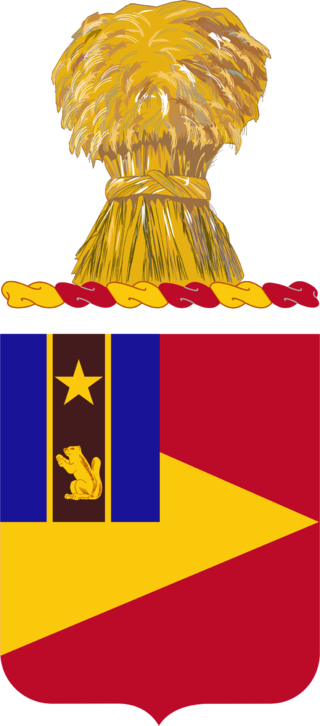History
The regiment was constituted on 10 November 1942 and activated at Camp Lockett, California on 25 February 1943, assigned to the 4th Cavalry Brigade of the 2nd Division. [2] The horses for the new regiment were chosen from Fort Bliss and the United States Army Remount Service at Fort Robinson. The Brigade, which the 28th was part of, relieved the 11th Cavalry Regiment from its border defense mission at Camp Lockett. The regiment was commanded by Colonel Edwin M. Burnett and conducted training in southern California while patrolling the Mexico–United States border. The 28th's enlisted men were all African American, and its 153-man cadre of non-commissioned officers were from the 10th Cavalry. The remainder of the enlisted men were draftees. The regiment was called upon to fight wildfires during the summer of 1943. [2] [4] The largest of these fires was the 16,000-acre Barrett-Cottonwood-Morena Fire. The 28th Cavalry personnel serving within the Cleveland National Forest were praised for their firefighting efforts by the Forest's supervisor. Even with this break in training the regiment proved ready to advance its combat training. In late 1943, the regiment was expected to move on to Desert Training Center, however Army Ground Forces decided that training in Louisiana would be preferential for horse cavalry maneuver. [5]
In December, the Department of War decided to send the division to North Africa, where it would be broken up into service units, which were needed more than cavalry. Around 12 January 1944, the regiment was alerted for movement and dismounted. It was moved by train to Camp Patrick Henry, Virginia, between 10 and 15 February, being brought up to strength by 243 replacements from Fort Huachuca. On 2 March, the regiment moved to Newport News from the camp. [2]
The regiment shipped out on 3 March 1944 from the Hampton Roads Port of Embarkation aboard the USS General William Mitchell. After arriving at Casablanca on 12 March, the regiment staged at Camp Don B. Passage near the city before departing for Oran by train. A little over two weeks after arrival in Algeria, on 31 March, the 2nd Cavalry Division and its component regiments were inactivated at Hassi Ben Okba near Oran. Troops from the 28th Cavalry were given the option of transferring to service units or volunteering for combat but at the loss of all rank. [2] Some troops from the 28th Cavalry were used to activate the 6487th Engineer Battalion. The regiment was formally disbanded on 12 December 1951. [7]

The 11th Armored Cavalry Regiment is a unit of the United States Army garrisoned at the Fort Irwin National Training Center in California. The regiment has served in the Philippine–American War, the Pancho Villa Expedition, World War II, the Vietnam War, Gulf War and Iraq War. The 11th ACR serves as the opposing force (OPFOR) for the Army and Marine task forces, and foreign military forces that train at Fort Irwin.

The 2nd Cavalry Division was a cavalry division of the United States Army.

The 6th Cavalry is a regiment of the United States Army that began as a regiment of cavalry in the American Civil War. It currently is organized into aviation squadrons that are assigned to several different combat aviation brigades.

The 4th Cavalry Brigade is an AC/RC unit based at Fort Knox, Kentucky. The unit is responsible for training selected United States Army Reserve & National Guard units that are based East of the Mississippi River. The brigade was originally formed as an element of the 2nd Cavalry Division but was inactivated after the division was broken up. The unit was formerly designated as 4th Brigade, 85th Division. The brigade is a subordinate unit of the 1st Army.

The 15th Cavalry Regiment is a cavalry regiment of the United States Army. It was one of the Expansion Units originally established for the Spanish–American War, but has been a general workhorse unit ever since.

Camp Lockett was a United States Army military post located in Campo, California, east of San Diego, and north of the Mexican border. Camp Lockett has historical connections to the Buffalo Soldiers due to the 10th and 28th Cavalry Regiments having been garrisoned there during World War II. It was named in honor of Colonel James R. Lockett who fought in the Spanish–American War, Philippine Insurrection, and the Punitive Expedition. There was an active preservation effort underway with long-term plans of creating the 'Camp Locket Historic District' in the National Register of Historic Places, which ended due to private property concerns. In 2009 it was designated as a California Historical Landmark, and there are plans to create a county park out of the majority of its former area.

The Engineer Special Brigades were brigade-sized amphibious forces of the United States Army developed during World War II and active from 1942 to 1955. Initially designated engineer amphibian brigades, they were redesignated engineer special brigades in 1943. The 1st, 5th, and 6th Engineer Special Brigades were assigned to the European Theater of Operations. The 1st Engineer Special Brigade participated in the landings in Sicily and Italy before joining the 5th and 6th Engineer Special Brigades for the invasion of Normandy.

The 27th Cavalry Regiment was a short-lived African American unit of the United States Army. The regiment was formed as part of the 2nd Cavalry Division in 1943 and inactivated in north Africa in 1944 without seeing combat.

The 76th Field Artillery Regiment is a field artillery regiment of the United States Army. First formed as a cavalry regiment in 1916, the regiment was converted to field artillery in 1917, and served in Europe during World War I with the 3rd Division and as a separate battalion during World War II, as well as in peacetime at Fort Knox, KY, and Fort Devens, MA. Since 1959, the regiment has been a parent regiment under the Combat Arms Regimental System and the U.S. Army Regimental System, with regimental elements serving with the 3rd Infantry Division in Germany and Operation Iraqi Freedom, with the 7th Infantry Division in Korea, and in the Army Reserve. No regimental elements are currently active.

The 104th Cavalry Regiment is a Regiment of the United States Army first established in 1921. Troop A, 1st Squadron is one of several National Guard units with colonial roots and campaign credit for the War of 1812.

The 168th Field Artillery Regiment was a Field Artillery Branch regiment of the Army National Guard.

The 302nd Cavalry Regiment was a cavalry unit of the United States Army during World War I, the interwar period, and the Cold War. It was activated in early 1918 but broken up in the middle of the year to form new artillery units. The unit was recreated as a New Jersey Organized Reserve unit during the interwar period, and was converted into a tank destroyer battalion after the United States entered World War II. Reactivated in 1971 and 1973 in the Army Reserve, it was represented by two squadrons in the 100th Division (Training).
The 310th Armored Cavalry Regiment was a California-based reconnaissance unit of the United States Army Organized Reserve Corps, which briefly existed after World War II. It was constituted in 1948, partially organized from existing units in 1949, and inactivated in 1950.

The 312th Cavalry Regiment was a cavalry unit of the United States Army during World War I and the interwar period. It was activated in early 1918 but broken up later that year to form new artillery units. The unit was recreated as an Oklahoma, Arizona, New Mexico, and Colorado Organized Reserve unit during the interwar period. It was converted into a signal aircraft warning regiment after the United States entered World War II.

The 323rd Cavalry Regiment was a cavalry unit of the United States Army during the interwar period. The unit was activated as a California, Washington, and Oregon Organized Reserve unit during the interwar period, although it was later relocated entirely to California. It was converted into a signal aircraft warning regiment after the United States entered World War II.

The 124th Cavalry Regiment is a United States Army cavalry regiment, represented in the Texas Army National Guard by 1st Squadron, 124th Cavalry, part of the 56th Infantry Brigade Combat Team at Waco.

The 94th Cavalry Regiment is a United States Army cavalry regiment, represented in the Minnesota Army National Guard by 1st Squadron, 94th Cavalry, part of the 1st Armored Brigade Combat Team, 34th Infantry Division, stationed at Duluth.
The 29th Cavalry Regiment (Composite School) was a United States Army cavalry that briefly existed during World War II. It was activated in 1943 at Fort Riley and inactivated in 1944.

The 249th Coast Artillery Regiment was a Coast Artillery Corps regiment in the Oregon National Guard. It garrisoned the Harbor Defenses of the Columbia, Oregon and Washington 1924–1944.

















